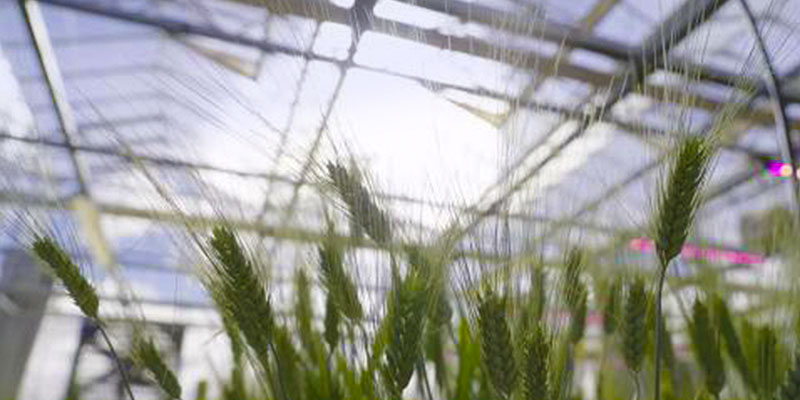We've had hundreds of plant breeder’s rights (PBR) applications for wheat varieties. Andrew Cecil from Australian Grain Technologies shares how they use PBR to protect their business.
Australian Grain Technologies - Andrew Cecil
Andrew Cecil:
My name's Andrew Cecil. I'm the General Manager of business at Australian Grain Technologies. I take care of the legal matters and in particular the intellectual property protection of Australian Grain Technologies' IP. I've been involved in plant breeding for over 20 years now originally at the University of Adelaide and now with Australian Grain Technologies.
Australian Grain Technologies is the largest breeder of field crop species in Australia. We breed wheat varieties, barley, canola, and lupin varieties and we put those varieties out in the marketplace for the farmers to grow.
Australian Grain Technologies actually has a mission of delivering high prosperity for Australian grain growers. We do this by breeding varieties with higher yield. Our yield can be delivered in a number of ways by having varieties that are tolerant to certain diseases such as striped rust leaf rust tolerant to heat, tolerant to abiotic stresses and soil constraints.
Australian Grain Technologies puts out about three or four new varieties every year. It takes about 10 years from the first cross through to release of a new variety. Australian Grain Technologies on an annual basis would produce approximately a thousand unique crosses of parental material. From those thousand crosses something like a million potential different genetic combinations are produced every year and they need to be tested in the field.
Plant breeders rights, often referred to in Australia as PBR, is fundamentally important to AGT. I'm actually the qualified person for Australian Grain Technologies. That means I'm authorised by IP Australia to undertake the trials that we do on an annual basis to show that our varieties are different to those that already exist.
AGT makes a decision about seeking PBR protection somewhere between 18 years after the initial cross. By that time we have an immense amount of data on our varieties. We know their yield, their disease tolerance, their ability to return financial benefit to the farmers and at that time we can then decide to put IP protection over that variety.
We would not release a variety without intellectual property protection. It means that we can then determine who is able to use our varieties, who would license those varieties, such as our seed growers and then ultimately a licence onto the farmers who will grow that variety and provide a return back to AGT so we can reinvest in further plant breeding.
The relationship we have with the PBR office is a collaborative one. We work with them on an ongoing basis on an annual basis to determine how we can best plant our comparative trials, work in those comparative trials and ensure that they are managed in a proper way to get the results that are required to obtain our intellectual property protection.
My name's Andrew Cecil. I'm the General Manager of business at Australian Grain Technologies. I take care of the legal matters and in particular the intellectual property protection of Australian Grain Technologies' IP. I've been involved in plant breeding for over 20 years now originally at the University of Adelaide and now with Australian Grain Technologies.
Australian Grain Technologies is the largest breeder of field crop species in Australia. We breed wheat varieties, barley, canola, and lupin varieties and we put those varieties out in the marketplace for the farmers to grow.
Australian Grain Technologies actually has a mission of delivering high prosperity for Australian grain growers. We do this by breeding varieties with higher yield. Our yield can be delivered in a number of ways by having varieties that are tolerant to certain diseases such as striped rust leaf rust tolerant to heat, tolerant to abiotic stresses and soil constraints.
Australian Grain Technologies puts out about three or four new varieties every year. It takes about 10 years from the first cross through to release of a new variety. Australian Grain Technologies on an annual basis would produce approximately a thousand unique crosses of parental material. From those thousand crosses something like a million potential different genetic combinations are produced every year and they need to be tested in the field.
Plant breeders rights, often referred to in Australia as PBR, is fundamentally important to AGT. I'm actually the qualified person for Australian Grain Technologies. That means I'm authorised by IP Australia to undertake the trials that we do on an annual basis to show that our varieties are different to those that already exist.
AGT makes a decision about seeking PBR protection somewhere between 18 years after the initial cross. By that time we have an immense amount of data on our varieties. We know their yield, their disease tolerance, their ability to return financial benefit to the farmers and at that time we can then decide to put IP protection over that variety.
We would not release a variety without intellectual property protection. It means that we can then determine who is able to use our varieties, who would license those varieties, such as our seed growers and then ultimately a licence onto the farmers who will grow that variety and provide a return back to AGT so we can reinvest in further plant breeding.
The relationship we have with the PBR office is a collaborative one. We work with them on an ongoing basis on an annual basis to determine how we can best plant our comparative trials, work in those comparative trials and ensure that they are managed in a proper way to get the results that are required to obtain our intellectual property protection.
Please note: case studies are examples of the way some organisations have chosen to manage their IP. These studies don't provide advice and your experience may be different.

